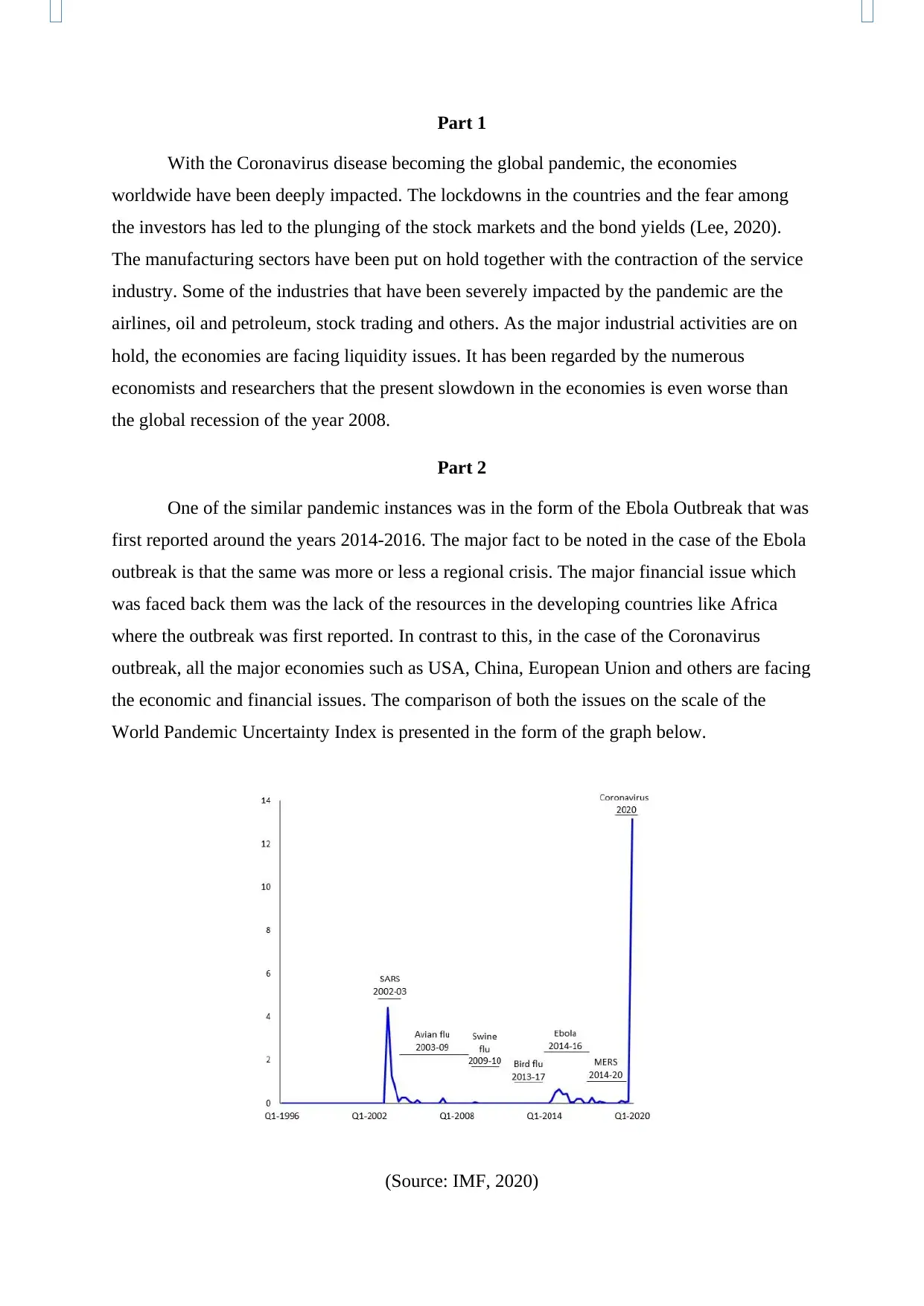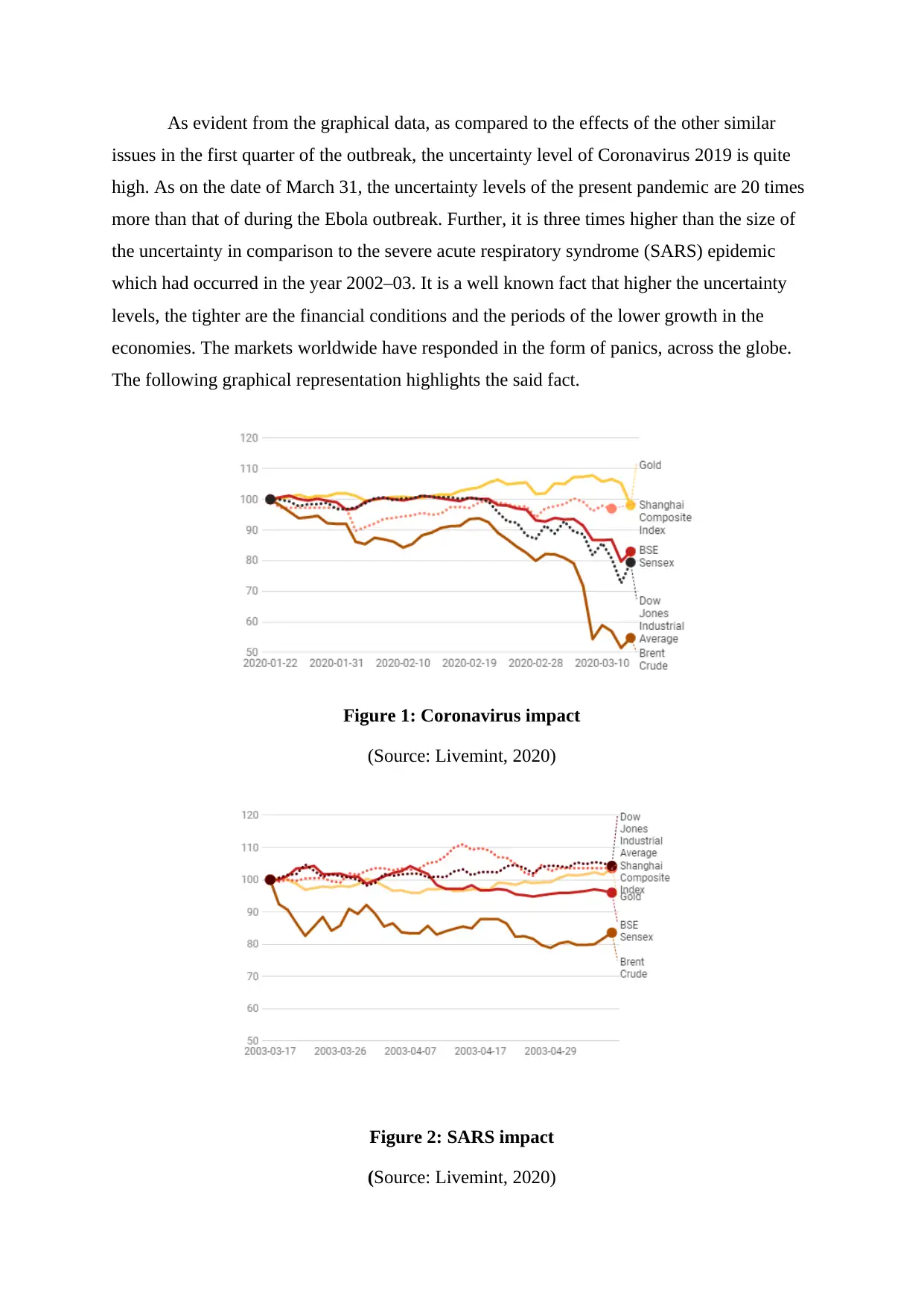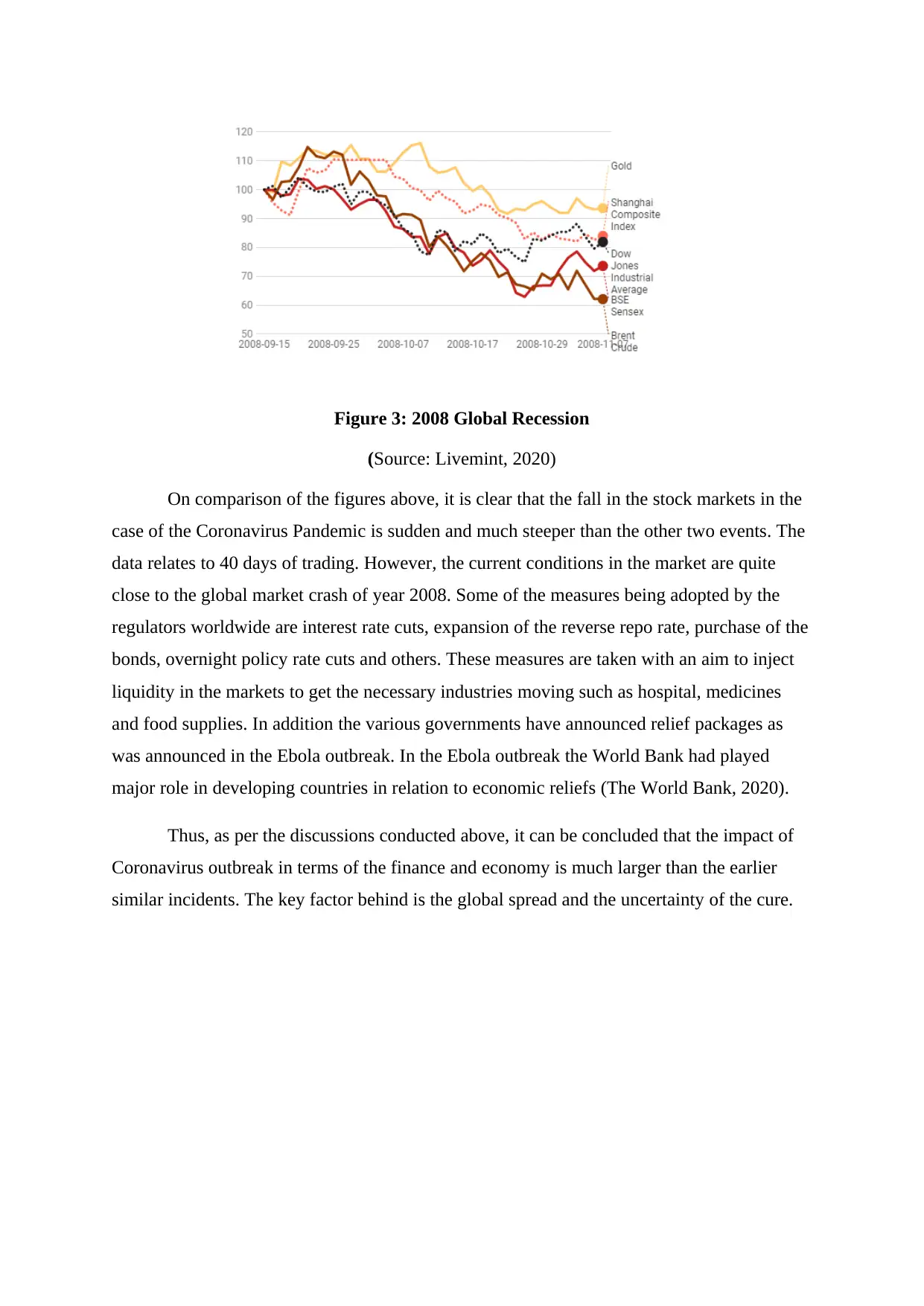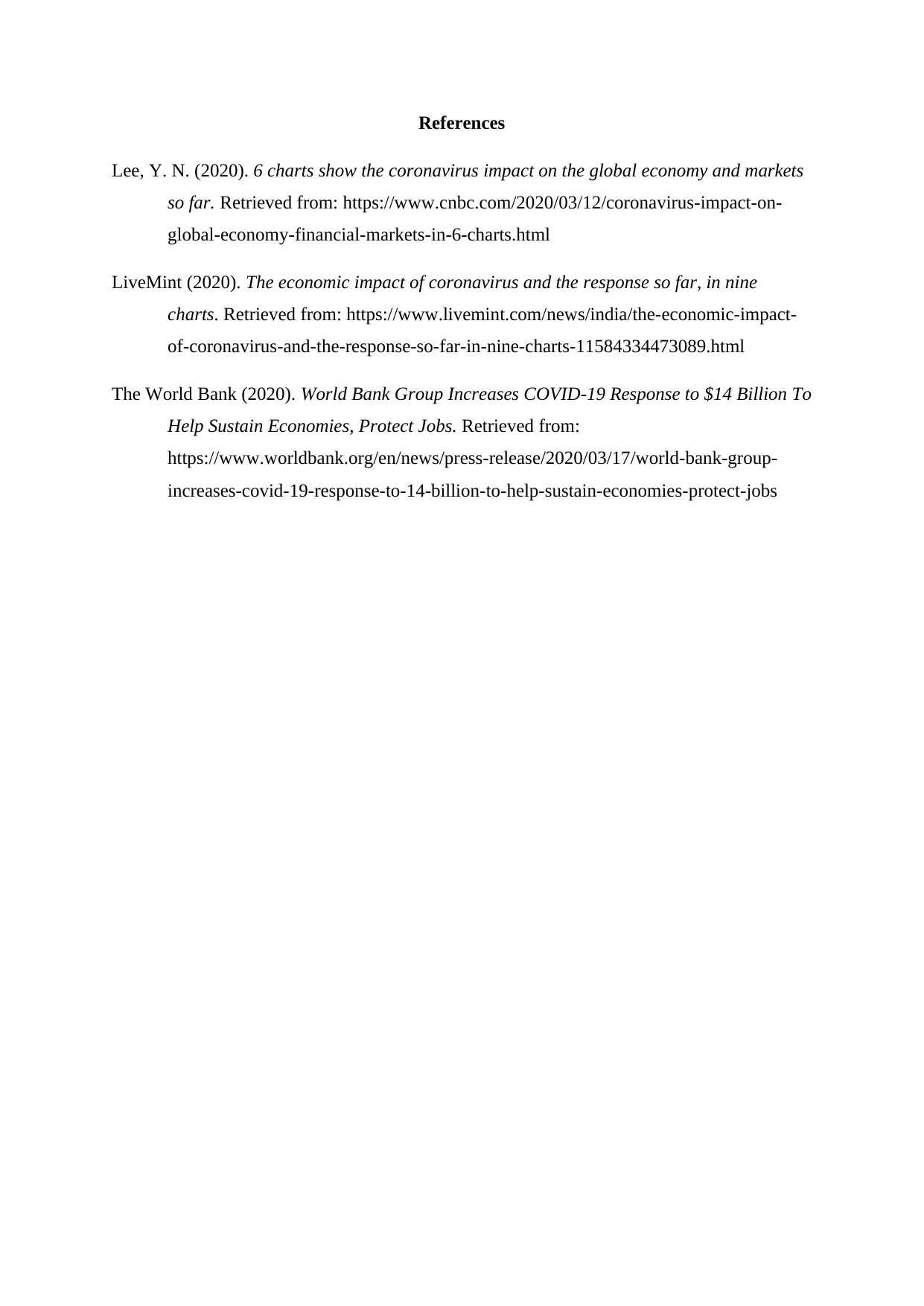Comparative Analysis: COVID-19 Economic Impact vs. Previous Events
VerifiedAdded on 2022/09/22
|5
|774
|33
Report
AI Summary
This report examines the economic impact of the COVID-19 pandemic, highlighting its severity compared to previous outbreaks like Ebola and the 2008 global recession. It analyzes the plunging of stock markets, contraction of industries, and liquidity issues faced by economies worldwide. The report uses graphical data to illustrate the high level of uncertainty associated with the Coronavirus, which is significantly higher than that of SARS and Ebola, and the market responses including panic selling. It compares the market crashes, and discusses the measures adopted by regulators globally to inject liquidity and provide relief. The conclusion emphasizes the far-reaching financial and economic consequences of the pandemic, driven by its global spread and the uncertainty surrounding a cure.

ENGLISH
Paraphrase This Document
Need a fresh take? Get an instant paraphrase of this document with our AI Paraphraser

Part 1
With the Coronavirus disease becoming the global pandemic, the economies
worldwide have been deeply impacted. The lockdowns in the countries and the fear among
the investors has led to the plunging of the stock markets and the bond yields (Lee, 2020).
The manufacturing sectors have been put on hold together with the contraction of the service
industry. Some of the industries that have been severely impacted by the pandemic are the
airlines, oil and petroleum, stock trading and others. As the major industrial activities are on
hold, the economies are facing liquidity issues. It has been regarded by the numerous
economists and researchers that the present slowdown in the economies is even worse than
the global recession of the year 2008.
Part 2
One of the similar pandemic instances was in the form of the Ebola Outbreak that was
first reported around the years 2014-2016. The major fact to be noted in the case of the Ebola
outbreak is that the same was more or less a regional crisis. The major financial issue which
was faced back them was the lack of the resources in the developing countries like Africa
where the outbreak was first reported. In contrast to this, in the case of the Coronavirus
outbreak, all the major economies such as USA, China, European Union and others are facing
the economic and financial issues. The comparison of both the issues on the scale of the
World Pandemic Uncertainty Index is presented in the form of the graph below.
(Source: IMF, 2020)
With the Coronavirus disease becoming the global pandemic, the economies
worldwide have been deeply impacted. The lockdowns in the countries and the fear among
the investors has led to the plunging of the stock markets and the bond yields (Lee, 2020).
The manufacturing sectors have been put on hold together with the contraction of the service
industry. Some of the industries that have been severely impacted by the pandemic are the
airlines, oil and petroleum, stock trading and others. As the major industrial activities are on
hold, the economies are facing liquidity issues. It has been regarded by the numerous
economists and researchers that the present slowdown in the economies is even worse than
the global recession of the year 2008.
Part 2
One of the similar pandemic instances was in the form of the Ebola Outbreak that was
first reported around the years 2014-2016. The major fact to be noted in the case of the Ebola
outbreak is that the same was more or less a regional crisis. The major financial issue which
was faced back them was the lack of the resources in the developing countries like Africa
where the outbreak was first reported. In contrast to this, in the case of the Coronavirus
outbreak, all the major economies such as USA, China, European Union and others are facing
the economic and financial issues. The comparison of both the issues on the scale of the
World Pandemic Uncertainty Index is presented in the form of the graph below.
(Source: IMF, 2020)

As evident from the graphical data, as compared to the effects of the other similar
issues in the first quarter of the outbreak, the uncertainty level of Coronavirus 2019 is quite
high. As on the date of March 31, the uncertainty levels of the present pandemic are 20 times
more than that of during the Ebola outbreak. Further, it is three times higher than the size of
the uncertainty in comparison to the severe acute respiratory syndrome (SARS) epidemic
which had occurred in the year 2002–03. It is a well known fact that higher the uncertainty
levels, the tighter are the financial conditions and the periods of the lower growth in the
economies. The markets worldwide have responded in the form of panics, across the globe.
The following graphical representation highlights the said fact.
Figure 1: Coronavirus impact
(Source: Livemint, 2020)
Figure 2: SARS impact
(Source: Livemint, 2020)
issues in the first quarter of the outbreak, the uncertainty level of Coronavirus 2019 is quite
high. As on the date of March 31, the uncertainty levels of the present pandemic are 20 times
more than that of during the Ebola outbreak. Further, it is three times higher than the size of
the uncertainty in comparison to the severe acute respiratory syndrome (SARS) epidemic
which had occurred in the year 2002–03. It is a well known fact that higher the uncertainty
levels, the tighter are the financial conditions and the periods of the lower growth in the
economies. The markets worldwide have responded in the form of panics, across the globe.
The following graphical representation highlights the said fact.
Figure 1: Coronavirus impact
(Source: Livemint, 2020)
Figure 2: SARS impact
(Source: Livemint, 2020)
⊘ This is a preview!⊘
Do you want full access?
Subscribe today to unlock all pages.

Trusted by 1+ million students worldwide

Figure 3: 2008 Global Recession
(Source: Livemint, 2020)
On comparison of the figures above, it is clear that the fall in the stock markets in the
case of the Coronavirus Pandemic is sudden and much steeper than the other two events. The
data relates to 40 days of trading. However, the current conditions in the market are quite
close to the global market crash of year 2008. Some of the measures being adopted by the
regulators worldwide are interest rate cuts, expansion of the reverse repo rate, purchase of the
bonds, overnight policy rate cuts and others. These measures are taken with an aim to inject
liquidity in the markets to get the necessary industries moving such as hospital, medicines
and food supplies. In addition the various governments have announced relief packages as
was announced in the Ebola outbreak. In the Ebola outbreak the World Bank had played
major role in developing countries in relation to economic reliefs (The World Bank, 2020).
Thus, as per the discussions conducted above, it can be concluded that the impact of
Coronavirus outbreak in terms of the finance and economy is much larger than the earlier
similar incidents. The key factor behind is the global spread and the uncertainty of the cure.
(Source: Livemint, 2020)
On comparison of the figures above, it is clear that the fall in the stock markets in the
case of the Coronavirus Pandemic is sudden and much steeper than the other two events. The
data relates to 40 days of trading. However, the current conditions in the market are quite
close to the global market crash of year 2008. Some of the measures being adopted by the
regulators worldwide are interest rate cuts, expansion of the reverse repo rate, purchase of the
bonds, overnight policy rate cuts and others. These measures are taken with an aim to inject
liquidity in the markets to get the necessary industries moving such as hospital, medicines
and food supplies. In addition the various governments have announced relief packages as
was announced in the Ebola outbreak. In the Ebola outbreak the World Bank had played
major role in developing countries in relation to economic reliefs (The World Bank, 2020).
Thus, as per the discussions conducted above, it can be concluded that the impact of
Coronavirus outbreak in terms of the finance and economy is much larger than the earlier
similar incidents. The key factor behind is the global spread and the uncertainty of the cure.
Paraphrase This Document
Need a fresh take? Get an instant paraphrase of this document with our AI Paraphraser

References
Lee, Y. N. (2020). 6 charts show the coronavirus impact on the global economy and markets
so far. Retrieved from: https://www.cnbc.com/2020/03/12/coronavirus-impact-on-
global-economy-financial-markets-in-6-charts.html
LiveMint (2020). The economic impact of coronavirus and the response so far, in nine
charts. Retrieved from: https://www.livemint.com/news/india/the-economic-impact-
of-coronavirus-and-the-response-so-far-in-nine-charts-11584334473089.html
The World Bank (2020). World Bank Group Increases COVID-19 Response to $14 Billion To
Help Sustain Economies, Protect Jobs. Retrieved from:
https://www.worldbank.org/en/news/press-release/2020/03/17/world-bank-group-
increases-covid-19-response-to-14-billion-to-help-sustain-economies-protect-jobs
Lee, Y. N. (2020). 6 charts show the coronavirus impact on the global economy and markets
so far. Retrieved from: https://www.cnbc.com/2020/03/12/coronavirus-impact-on-
global-economy-financial-markets-in-6-charts.html
LiveMint (2020). The economic impact of coronavirus and the response so far, in nine
charts. Retrieved from: https://www.livemint.com/news/india/the-economic-impact-
of-coronavirus-and-the-response-so-far-in-nine-charts-11584334473089.html
The World Bank (2020). World Bank Group Increases COVID-19 Response to $14 Billion To
Help Sustain Economies, Protect Jobs. Retrieved from:
https://www.worldbank.org/en/news/press-release/2020/03/17/world-bank-group-
increases-covid-19-response-to-14-billion-to-help-sustain-economies-protect-jobs
1 out of 5
Related Documents
Your All-in-One AI-Powered Toolkit for Academic Success.
+13062052269
info@desklib.com
Available 24*7 on WhatsApp / Email
![[object Object]](/_next/static/media/star-bottom.7253800d.svg)
Unlock your academic potential
Copyright © 2020–2025 A2Z Services. All Rights Reserved. Developed and managed by ZUCOL.





